SML2298
PhenDC3
≥97% (HPLC), powder, G-quadruplex ligand
Synonym(s):
3,3′-[1,10-Phenanthroline-2,9-diylbis(carbonylimino)]bis[1-methylquinolinium] 1,1,1-trifluoromethanesulfonate (1:2), Phen DC3, Phen-DC(3), Phen-DC3
About This Item
Recommended Products
product name
PhenDC3, ≥97% (HPLC)
Assay
≥97% (HPLC)
form
powder
color
white to beige
solubility
DMSO: 2 mg/mL, clear
storage temp.
2-8°C
SMILES string
O=C(NC1=CC2=CC=CC=C2[N+](C)=C1)C3=CC=C4C=CC5=CC=C(N=C5C4=N3)C(NC6=CC7=CC=CC=C7[N+](C)=C6)=O.O=S([O-])(C(F)(F)F)=O.O=S([O-])(C(F)(F)F)=O
Application
- as a quadruplex (G4) ligand to study its effects on the binding of RNA quadruplex (rG4) to nucleolin (NCL)
- as a DNA/RNA G-quadruplexes (GQs) ligand to study its effects on the expression of double homeobox 4 (DUX4) gene
- as a G4 ligand to study its stability and selectivity towards pre-miR-92b rG4 complex and duplex DNA by fluorescence resonance energy transfer (FRET)-melting assay
Biochem/physiol Actions
Storage Class Code
11 - Combustible Solids
WGK
WGK 3
Flash Point(F)
Not applicable
Flash Point(C)
Not applicable
Certificates of Analysis (COA)
Search for Certificates of Analysis (COA) by entering the products Lot/Batch Number. Lot and Batch Numbers can be found on a product’s label following the words ‘Lot’ or ‘Batch’.
Already Own This Product?
Find documentation for the products that you have recently purchased in the Document Library.
Customers Also Viewed
Our team of scientists has experience in all areas of research including Life Science, Material Science, Chemical Synthesis, Chromatography, Analytical and many others.
Contact Technical Service













